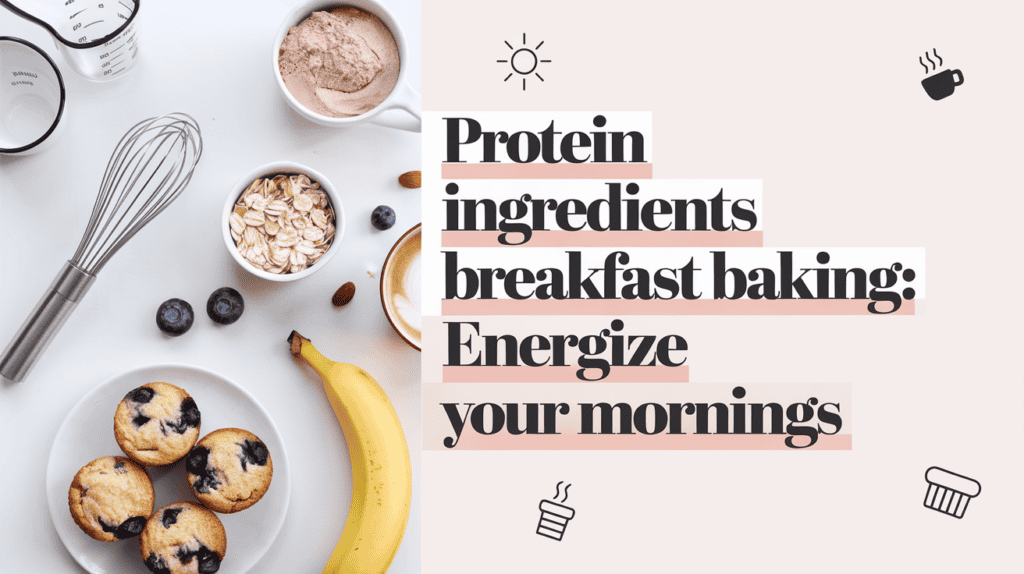
Table of contents
Imagine starting your day with a breakfast that not only tastes incredible but also fuels your body with essential protein! In this article, I’ll share insights into the best protein ingredients for breakfast baking: energize your mornings, reveal surprising benefits backed by research, and offer creative recipe ideas.
Whether you’re a baking enthusiast or a health-conscious foodie, get ready to transform your morning routine with protein-packed delights that include protein ingredients for breakfast baking!
This post may contain some affiliate links. As an Amazon Associate, I may earn from qualifying purchases at no extra cost to you. Some products may have been gifted for testing and review. Additionally, some content on this website has been created with the assistance of AI.
Understanding Protein Ingredients
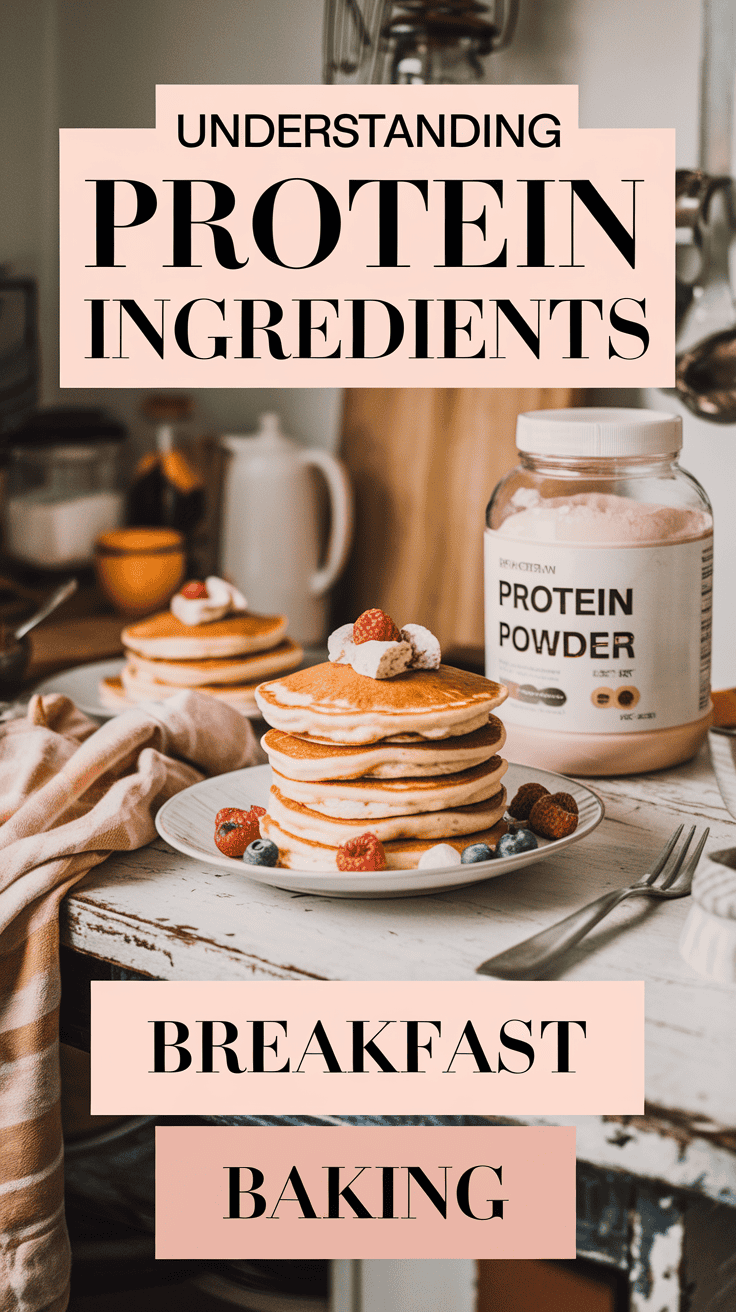
What Are Protein Ingredients?
I remember the first time I really got into the nitty-gritty of protein ingredients—it was a total game-changer for my breakfast baking. I used to just toss in a scoop of whey protein without knowing any better, and boy, did that sometimes result in a dense, chalky pancake! Over time, I learned that understanding the different types of protein ingredients can not only improve your recipes but also boost your energy levels throughout the day.
The Variety of Protein Types
Protein ingredients come in all shapes and forms, like whey, casein, plant-based proteins (soy, pea, rice), and even egg protein. Each one brings its own set of benefits and challenges when you’re baking. For instance, whey protein is great for a light, fluffy texture, while plant-based proteins can add a bit of nuttiness that works surprisingly well in muffins and breads.
Balancing Protein in Your Recipes
One of my biggest lessons was realizing that balancing protein with other ingredients is key. When I first experimented, I made the mistake of using too much protein, which turned my recipe into a rubbery mess. Now, I always stick to a ratio that blends protein with healthy fats and fiber. This not only improves texture but also ensures that my baked goods are nutrient-dense and more satisfying. For instance, try substituting half the flour with your chosen protein powder and adjust the liquids accordingly to keep the batter smooth and workable.
Here are some additional tips to help you nail that perfect balance:
- Start Small: Begin by replacing just 10-15% of your flour with protein powder. This lets you see how your batter behaves without risking a drastic change in texture. Gradually work up to 25-30% as you gain confidence.
- Mind the Liquids: Protein powders absorb liquids differently than traditional flours. If your batter seems thicker or drier than usual, add a splash more almond milk or water. Keeping a measuring cup handy makes it easy to adjust as needed.
- Mix It Up: Don’t rely solely on one protein source. Combining dairy-based proteins like whey with plant-based options can create a balanced profile that improves both nutrition and texture. For example, mixing a little whey with pea protein can offer creaminess along with extra fiber.
- Healthy Fats and Fiber: Integrate ingredients rich in healthy fats and fiber—like avocado, nut butter, or chia seeds—to counterbalance any dryness. These additions not only boost moisture but also contribute to a nutrient-dense recipe that keeps you full longer.
- Adjust Baking Times: With increased protein content, your baked goods might need a bit longer in the oven. Keep an eye on your creations and use the toothpick test to ensure they’re baked perfectly without becoming overdone.
- Enhance Flavor: Protein powders can sometimes carry a slight aftertaste. Enhance your recipe with natural flavor boosters like vanilla extract, cinnamon, or citrus zest to elevate the overall taste and mask any unwanted flavors.
With these tips, you’ll be well on your way to creating perfectly balanced, protein-infused recipes that are both nutritious and delicious.
Choosing Quality Protein Products
I also learned that not all protein powders are created equal—quality matters a lot! Some brands have additives or artificial sweeteners that can alter the flavor of your dish, so I always go for products that are clean and minimally processed. My go-to is a natural whey protein isolate, which has a neutral taste and blends seamlessly with other ingredients. I remember a time when I used a flavored protein powder in a savory muffin recipe, and it was a total disaster. Lesson learned: keep the flavors in check and match your protein to the dish you’re making.
Mixing with Whole Food Sources
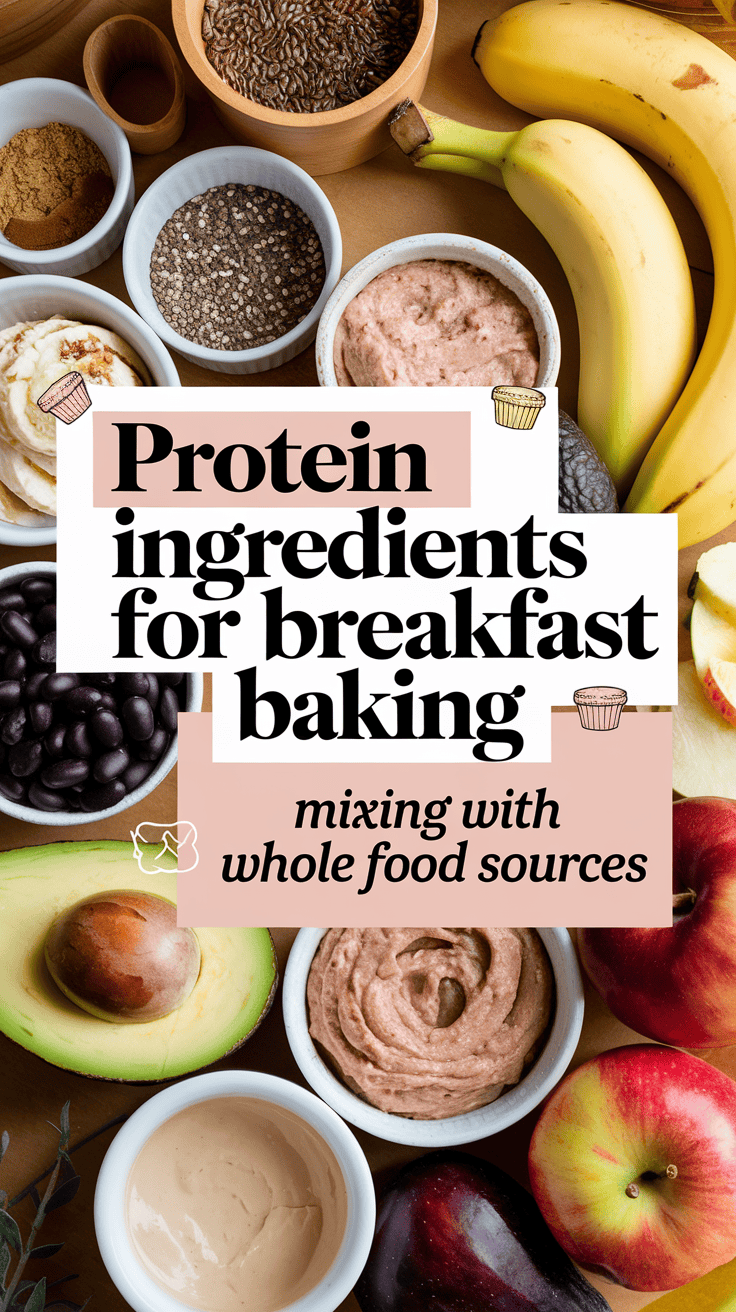
Another fun discovery was mixing protein ingredients with whole food sources. I sometimes add chia seeds or ground flaxseeds along with my protein powder, which not only ups the protein content but also adds a nice crunch and extra fiber. This combo really works well for me when I’m preparing protein-rich pancakes or energy bars. And hey, don’t be afraid to experiment with different textures—the slightly gritty feel of some plant-based proteins can be a cool twist in certain recipes if you balance it with smooth ingredients like mashed bananas or applesauce.
Tips and Experimentation
If you’re just starting out, my advice is to experiment in small batches. Take notes on what works and what doesn’t—trust me, your taste buds (and your waistline) will thank you later. I often jot down little tweaks on a notepad, like adding an extra splash of almond milk or a pinch more baking soda to get that perfect rise. Sometimes, mistakes lead to some of the best innovations in your recipes, so embrace the trial-and-error process!
Picture This
A sunny morning, your kitchen filled with the aroma of freshly baked protein pancakes and a plate full of fluffy, flavorful treats that not only taste amazing but are also good for you. That sensory-rich moment where every bite fuels your body and warms your heart—that’s the magic of truly understanding protein ingredients in breakfast baking. It transforms your cooking into an art form that nourishes both body and soul!
Benefits of Incorporating Protein in Breakfast Baking
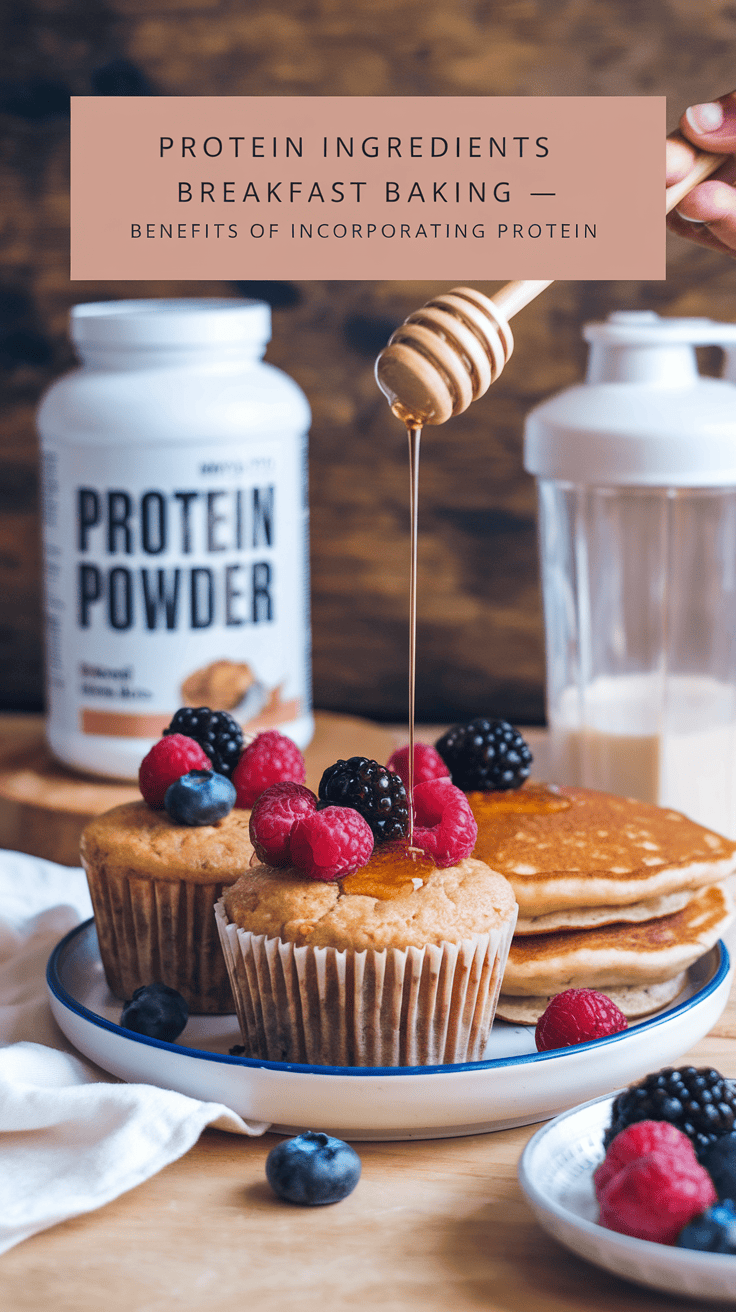
Boosts Energy Levels
I can’t even begin to tell you how much a protein-rich breakfast can transform your day. I remember those mornings when I’d skip protein-packed meals, only to feel sluggish by mid-morning. Now, I always start with a protein-enhanced recipe, and honestly, it’s like hitting the energy jackpot!
Protein provides sustained energy that helps me power through my busy days, whether I’m at work, running errands, or enjoying my hobbies. Plus, when you mix in whole food protein sources like chia seeds or nut butters, you’re not only getting a quick energy boost but also a dose of essential nutrients that help stabilize your blood sugar.
- Action Tip: Experiment by adding a scoop of your favorite protein powder to your pancake batter or smoothie bowl.
- Pro Tip: I like to prepare my protein-packed overnight oats, letting them sit in the fridge so that all those nutrients are ready to kick in first thing in the morning.
Supports Muscle Health
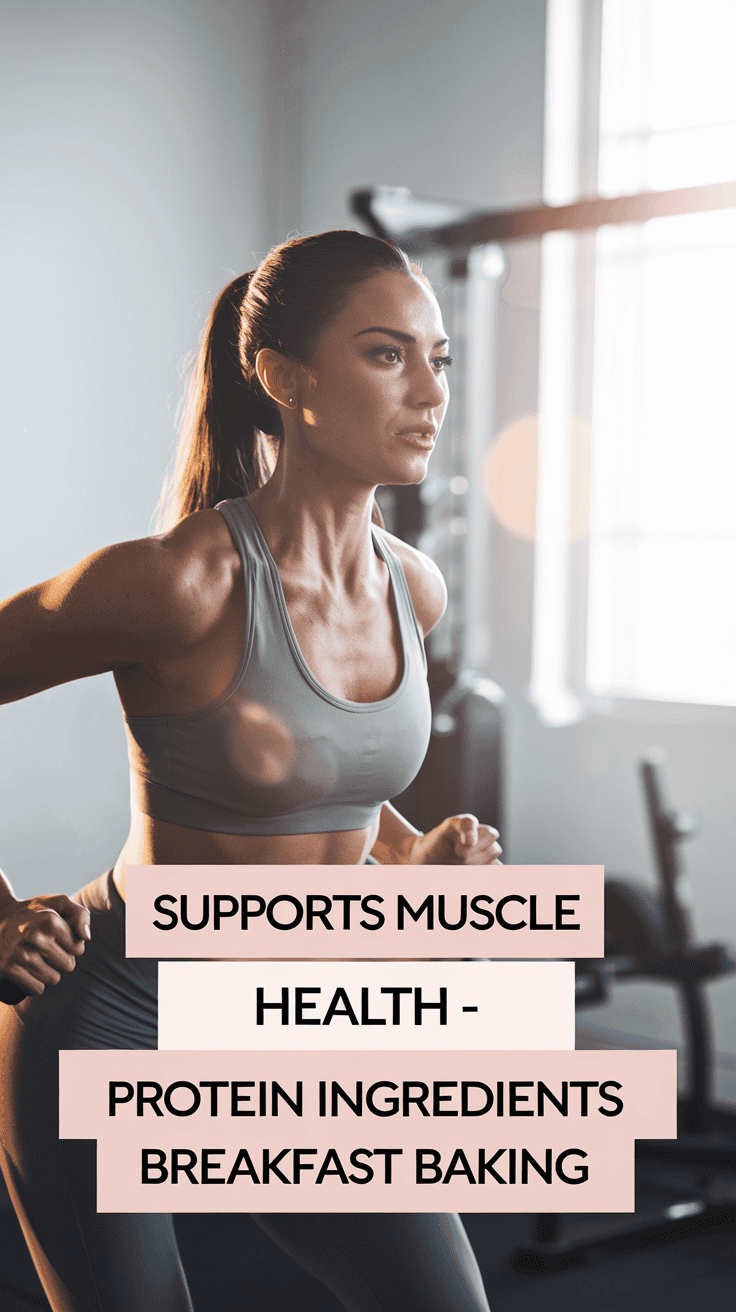
After a typical day that includes a solid workout mixed with daily activities, I’ve learned firsthand how crucial muscle recovery is. Incorporating protein into my morning routine not only fuels my energy for the gym but also helps repair and build muscle over time. Even if you’re not training like an athlete, a good workout can leave your muscles in need of some TLC. Protein is key for rebuilding muscle fibers that break down during exercise and trust me; it makes a noticeable difference in how strong and refreshed you feel the next day.
- Action Tip: Include a mix of dairy-based proteins like whey or plant-based options if you’re dairy-free to support your muscle health.
- Pro Tip: A fun tip from my kitchen diary is to add a spoonful of Greek yogurt to your protein muffins. It not only gives them a moist texture but also packs in extra muscle-building protein for a more balanced meal.
Enhances Recipe Nutritional Profile
One of the most exciting things I’ve discovered is how protein can take an ordinary recipe and turn it into a nutritional powerhouse. When you incorporate quality protein into your baking, your recipes aren’t just tasty—they become nutrient-dense, balanced meals that nourish your body.
I’ve experimented with everything from protein-rich bread to high-energy muffins, and each time, the added protein has elevated the overall health profile of the dish. This means more vitamins, more minerals, and more of that oh-so-important satiety that keeps you feeling full for longer periods.
- Action Tip: Try substituting a portion of your flour with protein powder in your baking recipes. It’s an easy swap that can significantly boost the protein content without compromising flavor.
- Pro Tip: I often blend protein powders with natural ingredients like mashed bananas or applesauce to ensure my baked goods maintain their moistness and rich flavor. This trick has helped me avoid that dry, crumbly texture I once dreaded!
Picture This
Imagine waking up to a perfectly balanced breakfast that not only looks gorgeous on your Pinterest board but also fuels your day with sustained energy, supports your muscle recovery, and gives you a nutrient-packed start. It’s like having a personal cheerleader on your plate, encouraging you to take on the day with a smile. That’s the real magic behind incorporating protein in breakfast baking—it’s not just about eating healthy; it’s about feeling energized, empowered, and ready to conquer your creative endeavors!
Popular Protein Sources for Baking

Dairy-Based Proteins
I remember the excitement when I first tried incorporating whey protein into my baking. Dairy-based proteins, like whey and casein, are fantastic for achieving a light, airy texture. Whey protein dissolves well and adds a subtle creaminess to muffins, pancakes, and breads.
Casein has a slower digestion rate, offering a sustained release of amino acids throughout the morning. I like adding a scoop of whey to my cookie recipes. You will be pleasantly surprised by how moist and tender the protein-packed cookies turn out. These proteins boost the overall mouthfeel of baked goods and keep them fluffy.
Plant-Based Alternatives
Plant-based proteins like soy, pea, and rice protein are excellent choices for those who prefer a dairy-free approach. I ventured into plant proteins when a friend recommended using pea protein in my pancake recipes. The results were unexpectedly delightful.
Soy protein offers a smooth texture and is rich in essential amino acids. Pea protein brings a mild, nutty flavor that pairs well with spices or fruit purees. Rice protein may feel a bit grainy, but it works well when blended with other flours.
Comparative Analysis
Comparing dairy-based and plant-based proteins reveals some interesting contrasts. Dairy proteins offer a smoother texture and superior binding properties ideal for delicate baked goods. They are also richer in essential amino acids.
Plant-based proteins provide additional dietary fiber and fewer allergens, making them accessible to a broader audience. They may require slight adjustments in liquid ratios to avoid dryness or crumbly texture. Sometimes, a blend of both types yields the best of both worlds.
Picture This
Imagine a sun-dappled kitchen with the aroma of freshly baked treats filling the air. A bowl of protein-rich batter is ready to be transformed into golden muffins and fluffy pancakes. Every bite bursts with flavor and wholesome goodness, promising a nutritious and delicious start to your day.
Tips for Perfect Protein-Infused Breakfast Recipes
Balancing Ingredients
One of the biggest challenges I faced in protein baking was figuring out the perfect balance between protein, carbohydrates, and healthy fats. I used to overload on protein powder and ended up with a dense, dry batter. Now, I mix in whole grains, fresh fruits, or a drizzle of olive oil to keep recipes tender and flavorful.
- Action Tip: Substitute only about 25-30% of your flour with protein powder to maintain a soft crumb.
- Pro Tip: Combine protein with complex carbs like oats or whole wheat and add healthy fats like avocado or nut butter.
Maintaining Texture and Flavor
I learned the hard way that protein powders can sometimes alter the texture and flavor of your recipes if you’re not careful. Adjusting liquid content, like adding an extra egg or a bit more milk, often saves the day. Enhance natural flavors with a splash of vanilla extract, cinnamon, or a hint of cocoa powder to balance any aftertaste.
Ingredient Substitutions
Sometimes, dietary restrictions or personal preferences require creative tweaks in the kitchen. I’ve adapted recipes using dairy-free alternatives like almond or coconut milk and swapped traditional flour with almond or oat flour for a gluten-free twist. Experimenting with a blend of flours often yields the best texture.
Picture This
Imagine a sunlit morning with a plate of perfectly baked muffins, their crumb soft yet sturdy, with subtle hints of vanilla and cinnamon. The aroma invites you to savor a bite that delivers a balanced burst of protein, complex carbs, and healthy fats, transforming breakfast into a delightful culinary experience.
Top Breakfast Baking Recipes Featuring Protein Ingredients
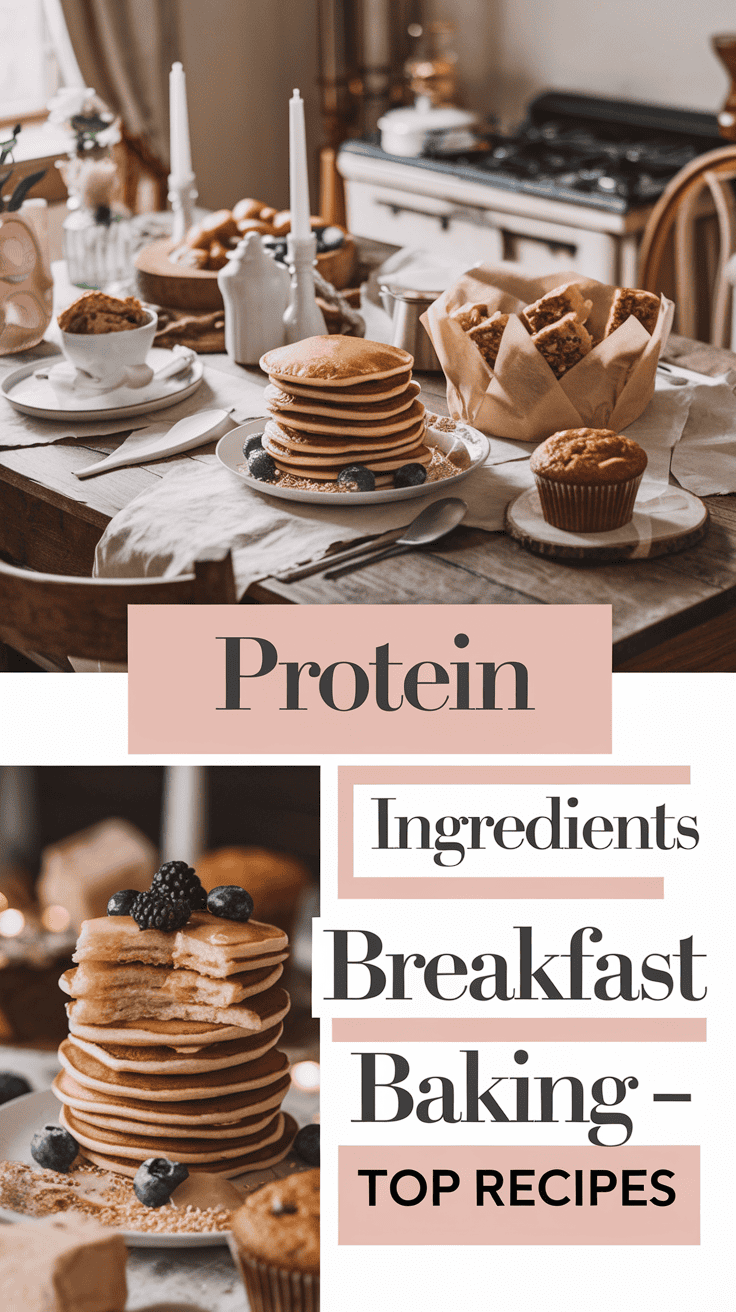
Protein Pancakes and Muffins
I’ve always been a sucker for pancakes and muffins, so incorporating protein into these breakfast staples was a no-brainer for me. When I first tried making protein pancakes, I followed a simple step-by-step method: blend oats, a scoop of protein powder, an egg, and a dash of almond milk until smooth.
I then poured the batter onto a hot griddle, flipping it once tiny bubbles formed. The result? Fluffy pancakes that packed an energy-boosting punch without being too dense.
For muffins, I start by mixing whole wheat flour with my favorite protein powder and a pinch of baking soda. I then fold in mashed bananas or berries for moisture and natural sweetness. Baking them until they’re just golden ensures a moist, tender crumb that’s perfect for busy mornings. Trust me, a well-crafted protein muffin is a game-changer on those hectic days!
Innovative Recipes
I love getting creative in the kitchen, and protein ingredients have opened up a whole new world of innovative recipes. One of my favorite experiments is protein granola bars. I mix rolled oats, chopped nuts, a scoop of protein powder, and a drizzle of honey with almond butter, then press the mixture into a tray and chill until firm. They’re a perfect grab-and-go snack, and I love tweaking the recipe by adding dried cranberries or a dash of cinnamon for an extra kick.
Another fun twist is protein waffles. I once swapped out a portion of the flour in my waffle batter for protein powder, and the texture was surprisingly light and crispy. Adding a sprinkle of flaxseeds not only ups the nutritional game but also gives a delightful crunch. These creative recipes prove that with a bit of experimentation, you can transform everyday breakfast items into something both nutritious and exciting.
Customization Options
One of the best parts about protein-infused recipes is that they’re super customizable. I’ve learned that small tweaks can make a huge difference, whether you’re adjusting for dietary needs or just tailoring flavors to your liking. For instance, if you’re dairy-free, I recommend using plant-based protein powders and swapping cow’s milk for almond or coconut milk. It’s all about finding that perfect balance that works for you.
I also encourage you to play around with flavor combinations. Love a bit of spice? Add some cinnamon or nutmeg. Prefer a fruity twist? Toss in blueberries or mashed apples. I sometimes experiment with a mix of different protein sources to combine the smooth texture of dairy-based proteins with the extra fiber from plant-based ones. Remember, there’s no one-size-fits-all—each tweak is a step toward your ideal breakfast masterpiece.
Picture This
Imagine sitting down to a breakfast spread that features golden protein pancakes, moist muffins, and inventive granola bars—all personalized just for you. Each bite delivers a satisfying blend of flavors and textures, energizing your day and proving that healthy can be incredibly delicious. Enjoy the journey of experimenting and finding what truly fuels your mornings!
Final Thoughts
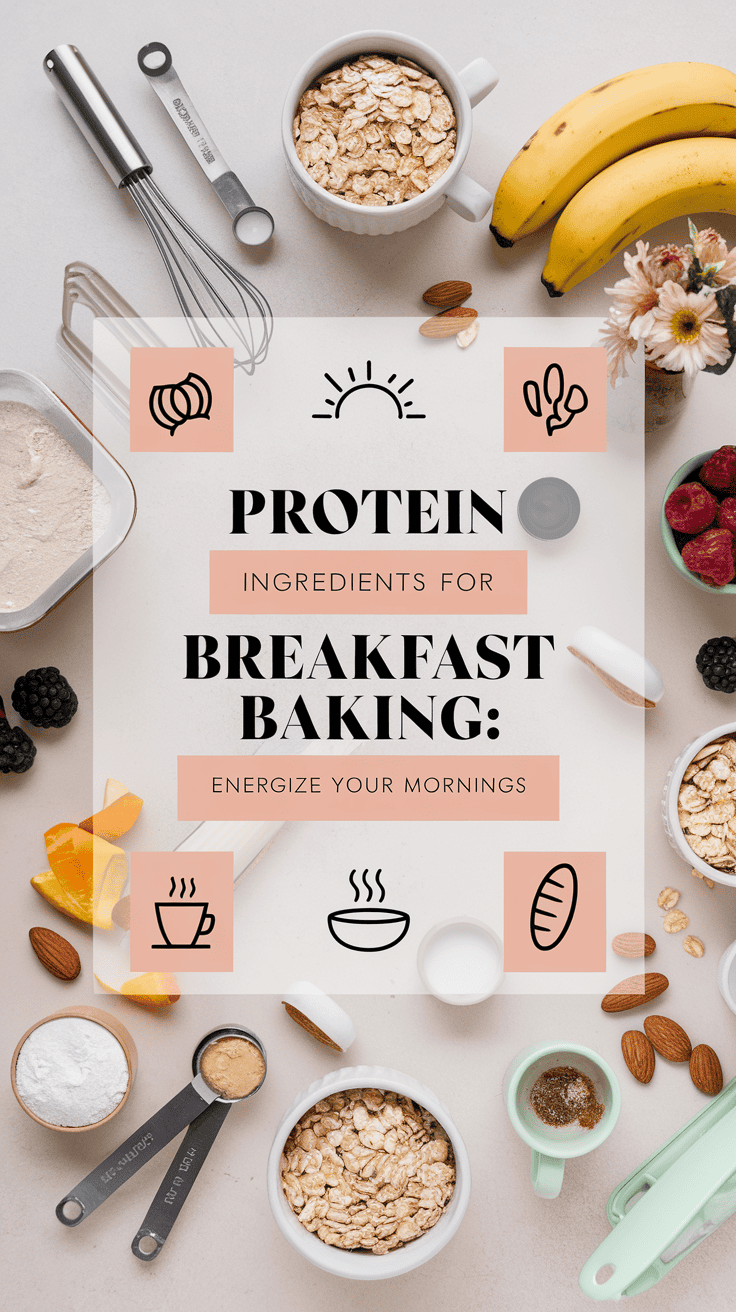
To sum it up, incorporating protein ingredients into your breakfast baking routine can revolutionize your mornings by delivering both flavor and nutrition. I hope this guide inspires you to experiment with new recipes and enjoy a healthier, more energetic start to your day. Ready to try something new? Dive into your kitchen and get creative with these protein-packed ideas!
This post may contain some affiliate links. As an Amazon Associate, I may earn from qualifying purchases at no extra cost to you. Some products may have been gifted for testing and review. Additionally, some content on this website has been created with the assistance of AI.
Frequently Asked Questions
What are the best protein ingredients to use for breakfast baking?
Whey protein and casein are popular dairy-based choices for a light, fluffy texture, while soy, pea, and rice protein offer excellent plant-based alternatives. Each protein type has its own benefits, so choosing the best one depends on your dietary needs and flavor preferences.
How can I balance protein with carbohydrates and fats to maintain a perfect texture?
The key is to substitute only a portion of your flour—around 25-30%—with protein powder, and then adjust the liquid content. Mixing in whole grains, healthy fats like olive oil or nut butter, and natural fibers from fruits or seeds creates a well-balanced recipe that remains moist and flavorful.
What are some effective dairy-free or plant-based protein alternatives for baking?
For those avoiding dairy, plant-based proteins such as soy, pea, and rice protein work wonderfully. They provide a nutty or slightly grainy texture that can be balanced with other ingredients, ensuring your baked goods remain tender and delicious.
How does incorporating protein impact the overall flavor and nutritional profile of baked goods?
Adding protein not only boosts the nutritional value—supporting muscle recovery and sustained energy—but also enhances the texture and moisture of your recipes. However, too much protein can alter flavor and density, so finding the right ratio is crucial for maintaining a pleasant taste.
Can I substitute a portion of my flour with protein powder, and what adjustments are needed for the liquid content?
Yes, you can substitute about 25-30% of your flour with protein powder. Since protein powders absorb liquid differently, you might need to add extra milk or water to achieve a smooth, workable batter. Experimentation is key—start with small batches until you perfect your recipe.
About The Author
Jahlila is a Transformational Whole Self and Wellness Lifestyle Empowerment Coach, a devoted mother, passionate writer, and a fervent advocate for holistic wellness. She is the creator of The Tri-Sync Method, a comprehensive coaching program designed to help women establish a personalized wellness and self-care lifestyle for enduring total health wellness.
Her journey has transitioned from focusing solely on health and fitness to embracing a broader mission: empowering women through holistic approaches that unite body, mind, and spirit. Jahlila is dedicated to teaching, coaching, writing, and speaking about how wellness intersects with a joyful, balanced life. Her mission is to motivate women to prioritize and achieve their wellness goals, fostering a deep connection between a vibrant lifestyle and true happiness. Ready to reclaim your vitality, achieve mental clarity, and embrace your wellness journey? Explore more at The Tri-Sync Method.Com
Don’t wait another day to start living your healthiest, happiest life. Schedule a Free Discovery Consultation with Jahlila today to explore how The Tri-Sync Method can transform your life. For additional questions or personalized guidance, please visit our Contact Page.

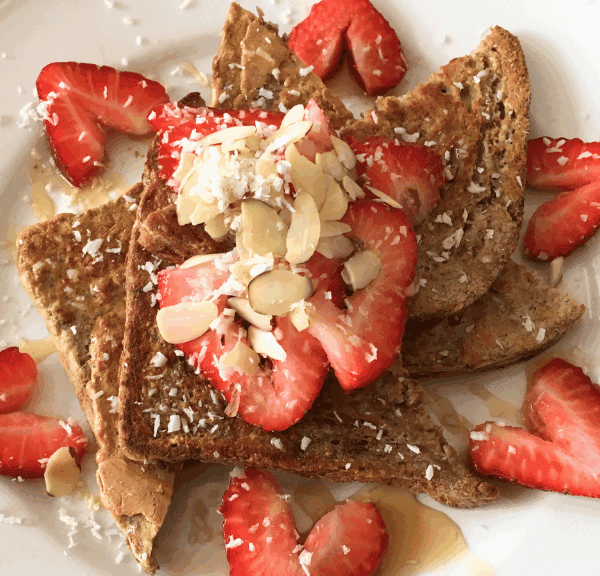
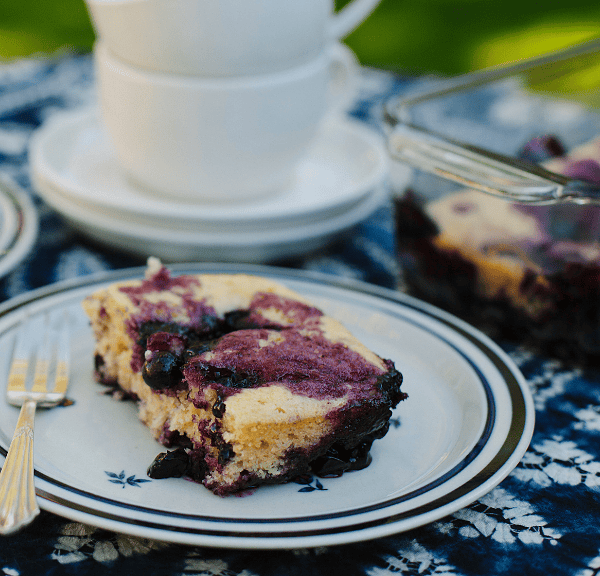
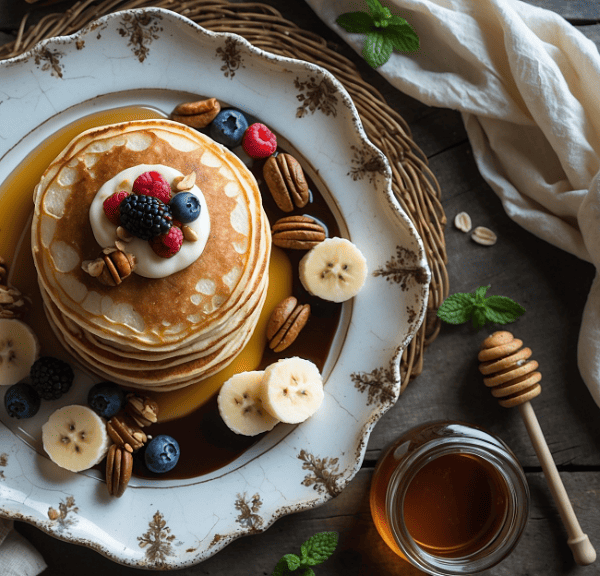
Leave a Reply